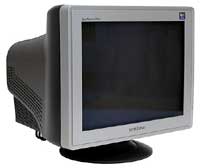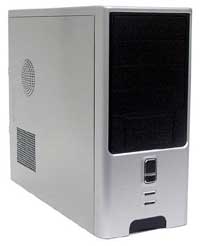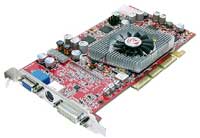AMD Budget Gaming System
If price is your biggest concern, then even $25 for a slightly faster component can be "too much". Such increases add up quickly, and that's what makes this the most difficult price goal to achieve without making compromises. In fact, it really isn't possible to build a "Budget" system that doesn't make some concessions to the almighty dollar. We have done our best, however, to build a system that will be capable of playing all the latest titles at acceptable rates for the next year or two at least. We have a couple of options from the AMD camp as well as one from the Intel side to help you out. We'll start with the absolute cheapest system that we would recommend for gaming, and follow that with a slightly updated system.
| Budget AMD Athlon 64 754 System |
| Hardware |
Recommended Component |
Price |
| Processor |
AMD Athlon 64 2800+ 512K 1.8 GHz (754) |
127 |
| Motherboard |
Chaintech VNF-250 (754) |
73 |
| Memory |
1x512MB Mushkin Basic 2.5-4-4 |
75 |
| Video Card |
Sapphire Radeon 9800 Pro 128 MB 256-bit |
196 |
| Hard Drive |
Seagate Barracuda 80GB EIDE model 7200.7 |
59 |
| Optical Drive |
NEC DVD+/-RW Drive Model 3500A |
72 |
| Case and Power Supply |
Athenatech A602 Black/Silver with 350W PSU |
62 |
| Display |
Samsung 793DF 17 Black/Silver CRT (1280x1024@75 Hz) |
139 |
| Speakers |
Use what you have |
0 |
| Keyboard and Mouse |
Logitech Optical Desktop Combo |
26 |
| Bottom Line |
|
829 |

Click to enlarge. |
The final price comes to a bit more than our $750 target. Unfortunately, it is difficult to get a quality gaming system without making some compromises. We don't include speakers either, on the assumption that most people will have some decent headphones or speakers already available. The same can be said of the monitor: if you already have a monitor with which you are content, you can stick with that for the time being. One nice feature of our Samsung is that it can provide a generally flicker-free 75 Hz refresh rate at its highest 1280x1024 resolution. Unless you need a complete system, those items are the prime candidates for reducing the cost to reach the $750 goal.

Click to enlarge. |
Keyboard and mouse are a personal choice, but we have stuck with the bare minimum for the time being. We prefer Microsoft and Logitech keyboards and mice for a variety of reasons, but they are certainly not the only option; so if your opinion differs from ours, get what you like. The case was one of the more difficult items to select. We like Antec cases for their quality and overall reliability, but there are a huge number of cases from which to choose, so we wanted to give some other options. The Athenatech case comes with a generic 350W PSU, but that will suffice for this configuration. It also has a rear 120mm fan and a cooling duct that sits above the CPU, allowing the HSF to draw in fresh, cool air directly.

Click to enlarge. |
The real core of any gaming system is not the case, speakers and monitor. Those are what others will see, and they may be important from an aesthetic point of view, but if you're only worried about games and you're on a budget, the motherboard, processor, and graphics card are where you want to spend the most money. The socket 754 platform may not have the long-term upgrade options of socket 939, but it does allow us to cut about $50 off the price without sacrificing a whole lot of performance. We have chosen the cheapest Athlon 64 available, the 2800+, which runs at 1.8 GHz. Performance in games is generally better than the Pentium 4 2.8 GHz chips, so the performance rating is deserved. The Sempron 3100+ is also an option that would save us another $20 or so, but we felt that the potential 64-bit enhancements, which should arrive in the next year or so, make it worthwhile, not to mention the larger 512K cache.

Click to enlarge. |
Our choice of graphics card goes to the Radeon 9800 Pro 128 MB. It is important to emphasize that we're looking at the version with a 256-bit memory interface, so make sure you choose the correct model if you want to remain with our selection. There are "9800 Pro" cards now shipping with 128-bit interfaces, and there are also the 9800SE cards that have lower clock speeds and half of the pixel pipelines. For gaming performance, there's almost a linear scaling with the amount of money spent on your graphics card these days. So, if you are willing to turn down some details, you could go with one of the other 9800 variants or even the 9600 Pro or 9600XT, but they are likely to have some issues with upcoming games within the next year or so. For this price bracket, it is also worth mentioning that the 256 MB cards are mostly pointless unless you have a 256-bit memory interface, and that combination tends to cost quite a bit more. If the difference in price between a 128 MB and a 256 MB card is relatively small - i.e. less than $25 - then a card with more RAM might be useful. Otherwise, save your money.
The remainder of the system is pretty much what you've seen us recommend in the past. The 80GB Seagate hard drive comes with a five-year warranty and provides ample storage. Performance differences between the various hard drives really are not that great unless you really spend a lot of money. The DVD+RW drive is our Editor's Choice NEC 3500A from the recent
Fall 16X DVDR Roundup, which provides good performance and features at a very low price. We could have gone with a cheaper optical drive instead of a DVD burner, but we prefer to have a system with CD/DVD burning capability. If you disagree, a DVD-ROM drive can be had for about $25, as can a CD-RW drive. We recommend DVD support for gaming systems, as some of the newer titles are shipping in both DVD and CD versions. Installing from one DVD is much more convenient than installing from four or more CDs, and we can only hope that more games will make the shift to DVDs. We did not include a floppy drive, but for an extra $9, you might want to toss one in just to be safe. There are still some hard drive controllers that require the use of a driver floppy in order to work with the Windows XP installation.














70 Comments
View All Comments
Arkali - Tuesday, November 23, 2004 - link
For Intel gaming you should have picked the new AOPEN socket 479 855GME motherboard and a Dothan processor.Glassmaster - Monday, November 22, 2004 - link
#30 Doesn't look like they are going to defend their PSU recommendations. I just want to know if they actually build and stress test these systems with the Generic PSUs to make sure their recommended systems really are reliable.Glassmaster.
Live - Monday, November 22, 2004 - link
I like the format of this guide. I think the guides in general has been a great addition to Anandtech.To bad PCI-e motherboards is not out yet. Since the sli previews are not out in force yet I'm still not 100% sure if its something you want on your motherboard for more upgradability but it sure looks like it is not. Too expensive both in terms of motherboard and the 2 cards. But for a gamer, investing in anything else then PCI-e seems like a bad move. Unless you like to buy second-hand. I bet a lot of AGP cards will soon be available on the market as the high end crowd switches to the latest.
mldeveloper - Monday, November 22, 2004 - link
i like the format of this guide, since i always jumped to the end to see the final price breakdown anyway.nurazlanshah - Monday, November 22, 2004 - link
is the a big difference in fps between 128mb and 256mb for a same graphic card?deathwalker - Monday, November 22, 2004 - link
Jarod...great writeup. Ignore all the sniping. It's a tough job doing a article like this and sometimes there just aren't any absolute rights and wrongs. Somepeople just like to pipe-off and be heard.AaronAxvig - Monday, November 22, 2004 - link
#15 I think if you really wanted maximum performance for a LOT of money, you would go with RAIDed SCSI. Very fast, no?Momental - Monday, November 22, 2004 - link
Fantastic article, Trog......I mean Jarrod. ;)I was considering going the SLI route with (2) two 6600GT's, but then realized that the performance is identical to that of one 6800GT. And who wants to take the chance of one of the GPU's defecating the bed? Additionally, the cost of the SLI-capable board ain't gonna be cheap. I will, however, wait for the VIA and nVidia PCI-e boards to become available before finally building a new system.
The only thing I might change from the mid-range system is to put in the lower latency RAM, such as the OCZ Plat Rev. 2 or the Ballistix. Pop on a good aftermarket HSF on the CPU and we're good to go!!
gilkman - Monday, November 22, 2004 - link
Very nice article. It's been a few years since my last homebuilt but with the new games it's def time to upgrade. I like the format of this article. It gives me a few more options and insight compared to the similar guides they have over at sharkeyextreme.comI am def looking at high end parts to put together and I was very interested in the Dell 20 inch widescreen LCD - Does anyone have any comments on using a widescreen LCD for games? The Dell widescreen has 16MS refresh and high resolutions, and I know that HL2 will support widescreen play, but what about other modern games like RTS's and RPG's? Is it safer to stick with a 4:3 screen?
SDA - Monday, November 22, 2004 - link
Looks good, but I object to using a cheap PSU for a lot of the systems. It's worth the small amount of extra money you pay to get a better PSU... a TON of the problems I've seen in DIY systems resulted from cheapo PSUs that couldn't deliver enough power or simply couldn't deliver clean enough power. Cheap PSU = false savings, IMHO. There are plenty of good PSUs out there for cheap (TTGI, CWT aka Antec).And yeah, sure, the budget rigs don't stress the PSU much. I still hold that you shouldn't go generic. Having looked inside a lot of generic PSUs, I can safely say that I wouldn't ever want to see one in ANY system I build.